LAB REPORT
Science and Technology Making Headlines
Jan. 13, 2017

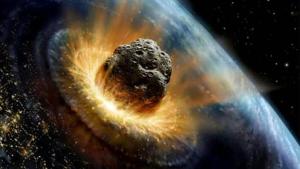
A comet recently came extremely close to colliding with Earth.
That was close
Astronomers had just two days warning that asteroid 2017 AG13 was coming. Discovered last Saturday, 2017 AG13 passed between Earth and the moon on Monday morning. At an estimated 36 to 111 feet wide, it’s no dinosaur killer, but even bus-sized rocks can do damage.
There are myriad challenges of managing and reducing the risks posed by both large and small near-Earth objects.
Every asteroid is different. As Megan Syal, a researcher at the Lawrence Livermore National Laboratory said: “There's really a lot of variables for an asteroid in a given scenario, including the composition, the porosity, the strength of the material, the way it sustains damage, the shape, its rotational state and its internal structure.”
The number of known asteroids grows every month, and both NASA and the White House are starting to invest real money in finding solutions.
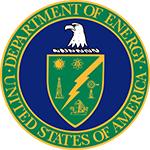
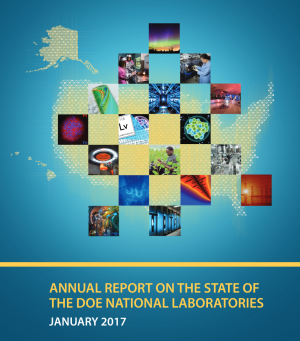
The Department of Energy recently released its first annual report of the national laboratories.
Science for the people
The Department of Energy has issued its first "Annual Report to Congress on the State of the DOE National Laboratories." It provides a comprehensive overview of the Lab system, covering S&T programs, management and strategic planning.
The report is written to better communicate the value that the laboratories provide to the nation. Future annual reports will be more compact, building on the extensive description of the laboratories and of the governance structures that are part of this first report.
From high performance computing to climate research to unique R&D facilities like the National Ignition Facility, Lawrence Livermore is featured prominently throughout the report and specifically on pages 171-172.

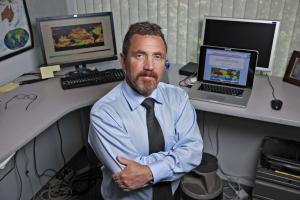
Ben Santer
Santer takes on political climate
After writing a letter to President-elect Donald Trump to reconsider his skepticism on climate change, Santer recently was featured on NPR’s “All Things Considered.”
Santer said it’s imperative that, as a climate scientist, he needs to persuade non-believers that climate change is real.
“We've got to try,” he said on the program. “As a climate scientist, if you spend your entire career trying to advance understanding, you can't just sit by idly and say nothing when that understanding is incorrectly dismissed as a hoax, a conspiracy, bunk, a contrived, phony mess. You have some societal responsibility to set the record straight. And that was what my open letter attempted to do -- to state in plain English -- not in jargon -- this is a real problem. And if we, as a country, back out of the Paris climate agreement, that would be a big mistake."
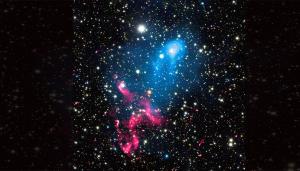
Astronomers have discovered a cosmic one-two punch unlike any ever seen in a pair of colliding galaxy clusters called Abell 3411 and Abell 3412. Image courtesy of X-ray: NASA/CXC/SAO/R. van Weeren et al; Optical: NAOJ/Subaru; Radio: NCRA/TIFR/GMRT
Astronomers catch sight of a double wammy
Astronomers have discovered a cosmic one-two punch unlike any ever seen before. Two of the most powerful phenomena in the universe, a supermassive black hole and the collision of giant galaxy clusters, have combined to create a stupendous cosmic particle accelerator.
By combining data from NASA's Chandra X-ray Observatory, the Giant Metrewave Radio Telescope (GMRT) in India, and other telescopes, researchers have found out what happens when matter ejected by a giant black hole is swept up in the merger of two enormous galaxy clusters. Lawrence Livermore contributed optical observations and analysis.
This cosmic double whammy is found in a pair of colliding galaxy clusters called Abell 3411 and Abell 3412, located about 2 billion light years from Earth. The two clusters are massive, each weighing about a quadrillion -- or a million billion -- times the mass of the sun.

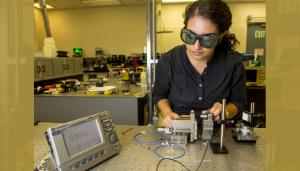
NIF & Photon Science postdoctoral researcher Leily Kiani tests a new optical fiber that could double the bandwidth of fiber-optic cables. Credit: Jason Laurea/LLNL
Amp packs a double feature
Lawrence Livermore researchers have developed a new kind of amplifier that could double the capacity of fiber optic cables.
Most of the data for the Internet travel on fiber-optic cables, which are made up of bundles of threads that transmit laser light. As the fiber gets longer, however, power is lost due to attenuation. In the late 1980s and early '90s, researchers discovered that they could mitigate this loss by developing inline fiber-optic amplifiers.
The team discovered that from 1,390 nanometers (nm) to 1,460 nm there is significant positive optical gain, and this new fiber generates laser power and optical gain with relatively good efficiency. This discovery opens the potential for installed optical fibers to operate in a transmission region known as E-band, in addition to the C and L bands where they currently operate -- effectively doubling a single optical fiber's information-carrying potential.

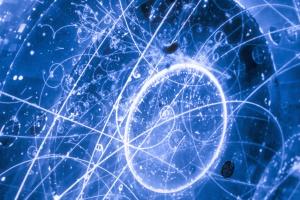
A colorized image shows the track of neutrinos as they zoom into a chamber. Illustration based on Fermilab bubble Chamber image.
PROSPECTing for neutrinos
In a host of experiments around the world, researchers, including those from Lawrence Livermore, are finding a deficit in the number of neutrinos (tiny massless elusive particles) they see versus what they expect to see, based on theory. And this has nothing to do with the shifting back and forth between the three flavors of neutrino that physicists already know about.
One possible explanation is that there is a fourth kind of neutrino that hasn't been detected. It's referred to as a sterile neutrino. And a team of scientists will begin looking for it next year as part of the Precision Oscillation and Spectrum Experiment (PROSPECT), a collaboration involving 68 scientists and engineers from 10 universities and four national laboratories.
To find the new particle or definitively disprove its existence, the PROSPECT collaboration is preparing to build a first-of-its-kind detector for short-range neutrino experiments, using a nuclear reactor as the neutrino source.





